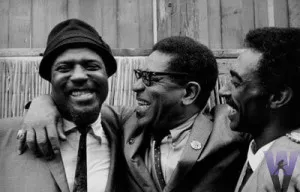Gerald Wilson died on Monday at the age of 96. The renowned trumpeter and bandleader was an active performer and recording artist until a couple of years ago, so he covered a lot of ground, and as an arranger he worked with just about everyone in the business. Wilson was born in Shelby, Mississippi on September 4, 1918. His mother, a graduate of Jackson College (now Jackson State University), taught music, and as Wilson recalled in Central Avenue Sounds: Jazz in Los Angeles, “The Wilson kids, my brother and sister, we all got a start in music very young. So being around music all my life, it was easy for me to pick up on it and begin to like it.”
Once he’d completed the eight grades then open to African-Americans in Shelby’s segregated schools, he moved to Memphis, where he attended Manassas High, the school where his future employer, Jimmie Lunceford, had once been a teacher. From there Wilson’s mother arranged for him to live with relatives in Detroit so that he could attend Cass Tech, which Wilson hailed as “one of the greatest music schools in the world even to this day.” Cass graduated many of the great Detroit musicians who emerged in the 40’s and 50’s, including Wardell Gray, Lucky Thompson, Della Reece, Kenny Burrell, and Donald Byrd. Wilson paid homage to Cass Tech on his 2009 recording, Detroit, and he speaks of it in this brief interview where he says that it still brings a “little tear” to his eye when he recalls the experience of attending an excellent, integrated school in 1934.
The frizzy-maned trumpeter’s professional career began in 1939 when he succeeded Sy Oliver in the Jimmie Lunceford Orchestra. He’d played around Detroit with McKinney’s Cotton Pickers and other locally-based outfits, but Lunceford was a plum assignment for a twenty-year-old. The band, as Wilson noted decades later, “was at the height of [its] fame. I was on top because they were on top. They were not a struggling band. They knew what the top was supposed to be. If we did seven shows, we changed seven times, from top to bottom…And they were strictly on their music.” He credited his training at Cass Tech for his readiness to work in such a “tough band…My harmonic techniques at that time were very far ahead.”
Wilson came to Los Angeles with Lunceford in February 1940. The change in climate between wintry Chicago and temperate Southern California made an immediate impact on him. “It was like eighteen degrees when we left. We had a Pullman and everything. Big time band. I’ll never forget that day in February. As I looked out the window of my bunk in the sleeper, I see this beautiful sunshine. We were somewhere like San Bernadino. And I said, ‘Well, this is going to be the place for me.’ I was very impressed with Los Angeles. I made up my mind that day that I was going to live in Los Angeles.”
Wilson’s early career highlights with Lunceford include an arrangement of “Sometimes I’m happy,” and the originals “Hi Spook” and “Yard Dog Mazurka,” the latter a robust, riff-laden extravaganza. A few years later, adapted by Ray Wetzel and re-titled “Intermission Riff,” it became a hit for Stan Kenton. In Central Avenue Sounds, Wilson claimed that “Yard Dog Mazurka” was “Just as vibrant today as it was then, and just as modern. You can see how far ahead I was.” Here’s the 1941 Lunceford original…
SoCal’s gain increased over time as Wilson left Lunceford in 1942, worked briefly with Les Hite and Benny Carter, then put together his own orchestra. It was the first of a succession of big bands he would lead over the next 70 years, in addition to the dozens of jobs he accepted as an arranger for Duke Ellington, Count Basie, Dizzy Gillespie, Ella Fitzgerald, Nancy Wilson, Ray Charles, and many more.
Wilson’s profile was prominent to West Coasters over the decades, and he was a perennial at the Monterey Jazz Festival, where the Gerald Wilson Award is presented annually to a promising, high-school age big band composer. Here he is at Monterey in 1963 with Thelonious Monk and Dizzy Gillespie in a photo that speaks not only of humor but of love and camaraderie.

Wilson recorded his own arrangements of Miles Davis’s “Milestones” and “So What” in the early ’60’s. The former was a radio hit that, Wilson maintained, propelled the original to greater prominence. “When Miles recorded it in 1958, nobody paid attention. We were the ones who made it a hit. Miles would come everywhere we performed and stay the whole night.” Here’s Wilson playing trumpet and leading his orchestra on Davis’s groundbreaking original, a bebop sandwich with a modal filling. It comes from his appearance on the early sixties Los Angeles television show hosted by Frank Evans. (Frankly Jazz has yielded a bonanza of clips in the YouTube era.)
Wilson credited his Mexican-American wife Josefina Villasensor for inspiring his interest in Spanish music and in bullfighting. He composed tributes to several matadors, and Spanish/Mexican themes were a prominent element in his compositional output. Here’s “Viva Tirado,” his 1967 tribute to the bullfighter Jose Ramon Tirado. Joe Pass is heard on guitar, Carmell Jones on trumpet, Jack Wilson on piano, and Teddy Edwards on tenor saxophone.